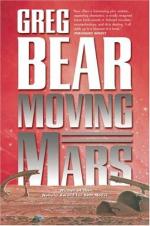|
This section contains 372 words (approx. 2 pages at 300 words per page) |

|
Moving Mars lies within both the familiar, realistic tradition of literature, and the tradition of hard science fiction. Bear acknowledges a general indebtedness to the hard science fiction pioneers Robert A. Heinlein, Isaac Asimov, Arthur C. Clarke, Theodore Sturgeon, as well as Ray Bradbury, Olaf Stapledon and the earlier English writer, H. G. Wells. Bear's naming of immigrants on Mars "the Eloi" honors Wells's The Time Machine (1895), in which beings called Eloi figure. Bear's naming of the "locusts" honors a story by Ray Bradbury, to whom Moving Mars is dedicated. Bear also has said that Moving Mars was conceived with great respect for the kinds of questions asked by Heinlein.
Casseia's space journey to Earth and her dismay at conditions on the homeland bear some resemblance to Heinlein's theme in "It's Great to be Back" (1947). Bradbury's The Martian Chronicles of 1950 contains the concept that settlers from...
|
This section contains 372 words (approx. 2 pages at 300 words per page) |

|




